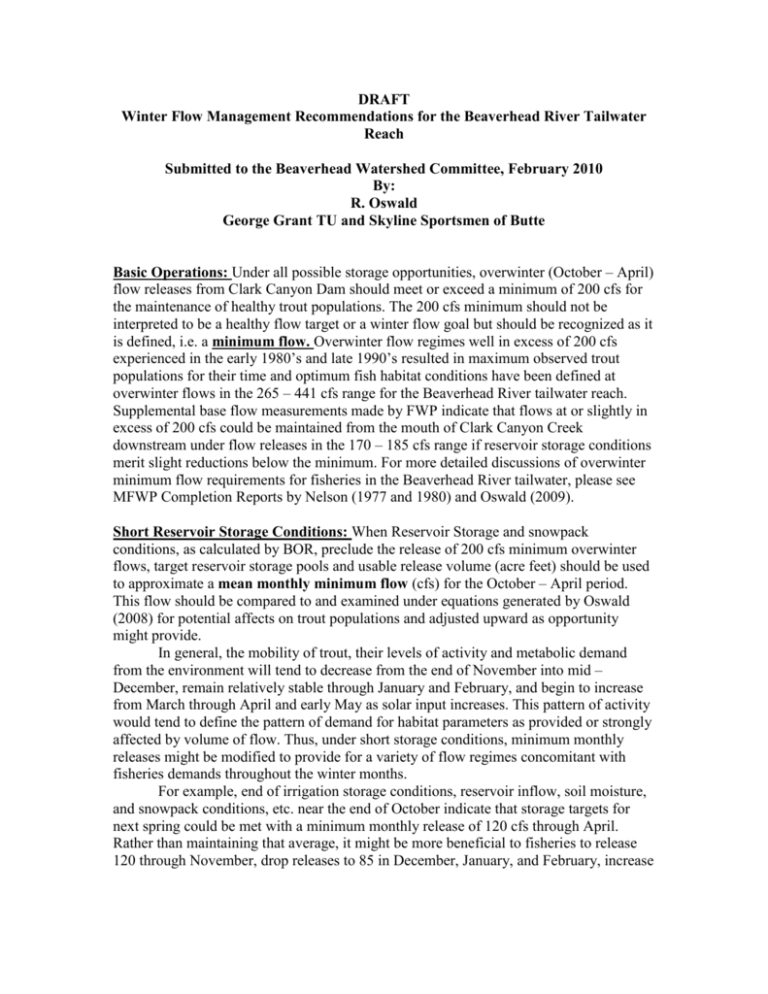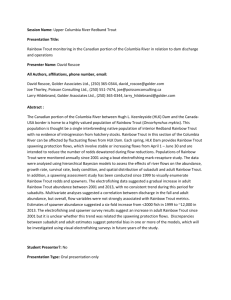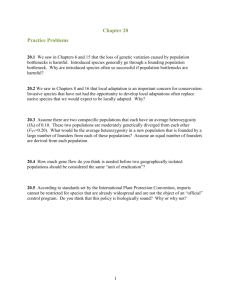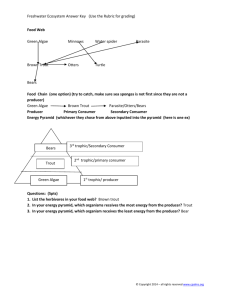BeaverheadFlowRecommendationsDRAFT
advertisement

DRAFT Winter Flow Management Recommendations for the Beaverhead River Tailwater Reach Submitted to the Beaverhead Watershed Committee, February 2010 By: R. Oswald George Grant TU and Skyline Sportsmen of Butte Basic Operations: Under all possible storage opportunities, overwinter (October – April) flow releases from Clark Canyon Dam should meet or exceed a minimum of 200 cfs for the maintenance of healthy trout populations. The 200 cfs minimum should not be interpreted to be a healthy flow target or a winter flow goal but should be recognized as it is defined, i.e. a minimum flow. Overwinter flow regimes well in excess of 200 cfs experienced in the early 1980’s and late 1990’s resulted in maximum observed trout populations for their time and optimum fish habitat conditions have been defined at overwinter flows in the 265 – 441 cfs range for the Beaverhead River tailwater reach. Supplemental base flow measurements made by FWP indicate that flows at or slightly in excess of 200 cfs could be maintained from the mouth of Clark Canyon Creek downstream under flow releases in the 170 – 185 cfs range if reservoir storage conditions merit slight reductions below the minimum. For more detailed discussions of overwinter minimum flow requirements for fisheries in the Beaverhead River tailwater, please see MFWP Completion Reports by Nelson (1977 and 1980) and Oswald (2009). Short Reservoir Storage Conditions: When Reservoir Storage and snowpack conditions, as calculated by BOR, preclude the release of 200 cfs minimum overwinter flows, target reservoir storage pools and usable release volume (acre feet) should be used to approximate a mean monthly minimum flow (cfs) for the October – April period. This flow should be compared to and examined under equations generated by Oswald (2008) for potential affects on trout populations and adjusted upward as opportunity might provide. In general, the mobility of trout, their levels of activity and metabolic demand from the environment will tend to decrease from the end of November into mid – December, remain relatively stable through January and February, and begin to increase from March through April and early May as solar input increases. This pattern of activity would tend to define the pattern of demand for habitat parameters as provided or strongly affected by volume of flow. Thus, under short storage conditions, minimum monthly releases might be modified to provide for a variety of flow regimes concomitant with fisheries demands throughout the winter months. For example, end of irrigation storage conditions, reservoir inflow, soil moisture, and snowpack conditions, etc. near the end of October indicate that storage targets for next spring could be met with a minimum monthly release of 120 cfs through April. Rather than maintaining that average, it might be more beneficial to fisheries to release 120 through November, drop releases to 85 in December, January, and February, increase to 100 between March 1st and 15th and increase to 145 cfs from March 15th through May 15th. Increasing snowpack data through the winter could similarly be applied to further adjust flows to benefit aquatic habitat and trout populations. Under that scenario, a very conservative short storage winter release of 75 cfs might be improved to 90 cfs in midMarch if snowpack conditions improved sufficiently. Spawning Conditions: The short storage adjustments discussed above could be modified to better accommodate the fall and spring spawning seasons in the tailwater reach. Brown trout and mountain whitefish are fall spawners utilizing windows from mid - October into early December dependant upon annual variations in the thermal regime of the reservoir and the distance of a particular reach from the dam. Rainbow trout and mottled sculpin (an important forage fish) are spring spawners generally using windows from early March through April and very early May. Spawning considerations in the Beaverhead River tailwater can readily be summarized under two rules of thumb. Sando (1981) demonstrated that spawning habitat availability for brown and rainbow trout was maximized as flow increased above the 200 cfs minimum while Nelson (1977) concluded that the amount of flow variation during the critical spawning period was the most important determinant in recruitment success. Thus, maintaining relatively ample and consistent flow regimes during and immediately post – spawning will afford the best chances of good trout recruitment with all other factors being equal. Extreme declines in flow during or after spawning could dewater and strand redds or reduce flow velocity over redds to allow for fine sediments to infiltrate egg pockets or fail to deliver required oxygen to developing fry. Conversely, extremely large flow increases during or immediately following spawning can mobilize gravels to crush developing eggs or embryos or actually bury redds. There are also, however, different variables in operation between the two major trout species in the Beaverhead River in regards to their respective spawning seasons, life histories, and population dynamics. As fall spawners, brown trout enter into the trauma of the spawning season as winter approaches and do not have a very good opportunity to recover prior to the onset of the winter “dormancy” period. Their eggs must remain in the gravels throughout the entire winter and do not hatch and emerge as swim-up fry until water temperatures begin to warm in early spring. Similarly, the post - spawn adults also do not get much of a chance to recover body weight and condition until about the same time of year. Thus, brown trout, and their redds, spend the winter in “suspended animation” and require little other than adequate flows and relatively stable flow conditions. Brown trout are also very strong river mainstem spawners, thus do not necessarily require access into tributaries, springs, or spring influenced channels to recruit juveniles into the population in a successful manner. Finally, a large preponderance of southwest Montana population data indicate that brown trout recruitment success varies inversely with adult population density. Thus, juvenile recruitment generally remains suppressed until strong adult cohorts decline affording a window of opportunity for one or two strong recruitment cohorts that will provide for the domination of the adult population until they also begin to decline at the end of their life span. As spring spawners, rainbow trout enter the trauma of spawning as water temperatures begin to increase, the productive cycle begins a spring “wake up” and runoff and increasing flow regimes dominate the channel. Thus, adult rainbow trout usually recover rapidly from spawning stress and eggs and embryos develop quickly after being deposited in the gravels. The two worse factors for rainbow trout recruitment are extremely cold spring water temperatures and abnormally high runoff flows that generate extreme alluvial processes. Rainbow trout do not spawn as efficiently in mainstem river channel situations as brown trout and require access to tributaries and springs. In the Beaverhead River, access to good spawning habitats is very critical at the Gordon and McMennomy Springs and along several areas of spring accretion between those two points. Finally, rainbow trout do not appear to exhibit the population “control” that the brown trout exhibit and tend to be more highly dependant upon regular recruitment into their populations. Due to limited high quality spawning habitats in the Beaverhead River, the rainbow trout populations remain highly localized in their distribution, at much lower density than the brown trout, and in need of restrictive angling regulations. Because of the reproductive and population dynamics differences between the two species, short flow management should generally emphasize recruitment conditions favoring rainbow trout. Thus, recommendations discussed above that managed limited storage availability for increases in river flow in March and April should serve rainbow trout recruitment well and also help in the recovery of adult brown trout and the development and emergence of brown trout fry. Brown trout population dynamics could trigger an exception to spring increases in overwinter flow management if the brown trout population was at a point where strong recruitment cohorts were needed as adult populations entered into decline. Consultation with the FWP fisheries management biologist would be required to ascertain if that condition was predominant. If strong brown trout recruitment was required, overwinter flow could probably be managed at the mean monthly estimation across the entire October – April period. An alternative might provide for slight flow declines (December – February) followed by slight spring increases (March – May) as long as those declines and increases were kept in the 25 – 50 cfs range (conservative hypothesis??) or within an acceptable percent fluctuation. The current sediment mobilization study could provide additional information in this area. Finally, a relatively abundant sub-minimum overwinter flow release regime could probably be spread equally as the empirical average over the October – April period to the benefit of both brown and rainbow trout recruitment. These abundant release regimes could be conservatively defined as those equal to or in excess of 150 cfs and be modified as more data is collected in the future.






